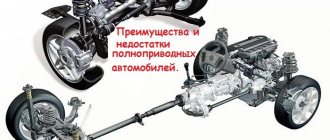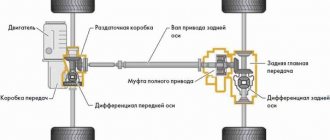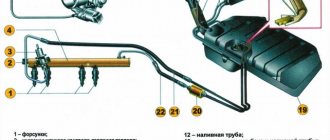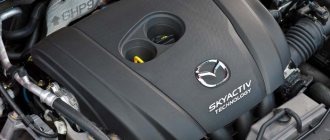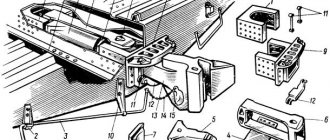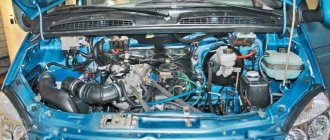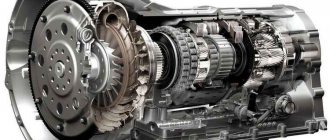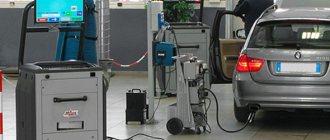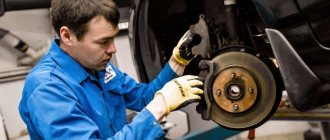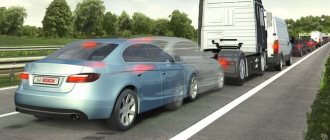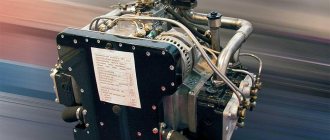SUVs and crossovers are especially popular among drivers, and many of them have one of the mentioned designations. By default, this is perceived by everyone as marking an all-wheel drive vehicle, which has the ability to transmit torque to all wheels, which ensures its ability to pass on any road. In general, this is true, but, as they say, the subtleties are in the details, and they sometimes determine the behavior of the car; In this case, the question will be raised: what is the difference between 4WD and AWD?
General information about all-wheel drive
An ordinary car is single-wheel drive, with torque supplied only to the front or only to the rear wheels. Here, probably, for a better understanding, you should use the figure below, showing the transmission features characteristic of an all-terrain vehicle.
The main feature of such a transmission (unlike single-wheel drive vehicles) is the presence of a transfer case. Thanks to it, torque is distributed between the axles of the car in the ratio established by the manufacturer. Of course, the mere presence of such a transmission element does not make a car an all-terrain vehicle, but all-wheel drive simply does not exist in the absence of a transfer case.
There are several different options for its implementation, but the most popular are the following:
- Part time 4WD. This is the name of the all-wheel drive that can be connected (if necessary), the rest of the time the car moves like a normal one. The use of such a system is possible only for a short time; its use on a dry and level surface ensures increased wear of the transmission and failure.
- Full time 4WD. This designates permanent all-wheel drive, when the torque is always distributed between the axles in the ratio established by the manufacturer. A car with this type of drive can move on any surface, but to obtain truly off-road capabilities it must be equipped with additional locks, for example, locking cross-axle and center differentials.
- AWD – four-wheel drive, activated automatically. The on-board computer or transmission elements (viscose clutch) themselves determine the moment of wheel slip and additionally connect another axle.
Of course, the description given is quite brief and incomplete, but it allows you to understand how the all-wheel drive mode is implemented.
Which one is better?
Knowing the features of popular types of all-wheel drive, you can already think about the advantages and benefits of each. Now, first of all, we are interested in what is the difference between 4WD and AWD and what they actually are. As already mentioned, they are practically the same thing. 4WD is a general designation for all-wheel drive, and often it implies the ability to manually supply torque to one of the axles (unused), providing the vehicle with increased cross-country ability, while AWD is an automatically connected (automatically) all-wheel drive (or permanent).
However, in many cases, this distinction is not respected, and both manufacturers and various media may imply or attach a completely different meaning to any of the abbreviations mentioned. The use of one or another all-wheel drive option should be based not on some letters and symbols, but on the specific technical characteristics and operating conditions of the machine.
AWD
All-wheel drive is a type of all-wheel drive that sends power to both axles, redistributing torque from the axle or wheel with less traction to the wheel with more. AWD systems are designed to improve road/ground traction and performance in all-weather conditions, as well as enhance the vehicle's capabilities in light to moderate off-road conditions.
One of the most common AWD setups involves a differential between the front and rear driveshafts, similar to some 4WD systems of yesteryear. Some cars use full-time all-wheel drive, which continuously sends power to all four wheels, while on others, one of the axles is engaged when needed. In such cases, a crossover or cross-country car (type) drives on a single drive.
The desired axle torque is often achieved through the use of electronically controlled traction control brakes, when the all-wheel drive system detects wheel slippage or sees a difference in wheel speed, the brakes are applied and controlled torque distribution occurs. Almost all modern all-wheel drive systems operate without driver intervention, controlled by an endless chain of computer codes using highly complex algorithms that monitor the steering, throttle and brakes. The only goal of this technological award is to improve road grip.
The new DYNAMAX all-wheel drive system has all this and even more, for example, it has sensors that read the road ahead of the car, proactively identifying areas with ice, potholes or water.
What to choose?
If you are thinking about purchasing an all-wheel drive vehicle and have not yet decided what to choose, you need to focus on the purpose of the car. Let's just say that there are differences in the handling of front-wheel drive and rear-wheel drive cars. Mountains of paper have been written on this topic and thousands of recommendations have been issued. But it is often quite difficult to predict how an all-wheel drive vehicle will behave in a given traffic situation.
Let's consider the simplest example - a slippery road, maybe it's raining, or there's light ice or swell. Your car has AWD according to current terminology. Under normal conditions, the car is front-wheel drive. You are taking a turn on a slippery road, at that moment the AWD suddenly kicks in, the driving conditions have changed and the car goes into a skid. It’s good if you can hold it and avoid an accident.
On the other hand, the drive, which is manually activated by the driver, is good especially on off-road conditions, when you have to overcome serious mud, and without special locks it cannot ensure free passage along such a road. So the difference between 4WD and AWD is manifested not only in their different designs, but also in the behavior of a car equipped with different types of transmissions.
If you try to determine which all-wheel drive vehicle to choose, then for hunting and fishing, active recreation, when you have to overcome off-road conditions, a car with permanent or, in extreme cases, manually connected all-wheel drive (with additional locks) is best suited. Whereas AWD is more suitable for driving conditions in the city, including on slippery and snow-covered roads. Although the choice is always yours, and it will be your decision.
All-wheel drive can be implemented in a variety of ways, and even the presence of a 4WD or AWD nameplate on a car does not mean that this is a real all-terrain vehicle that can handle any road. If you are concerned about purchasing a real jeep, then the choice must be made based on the conditions of its operation and the roads on which you will have to drive.
For many of us, these abbreviations are not just a set of Latin letters. Unfortunately, there are a large number of car enthusiasts who do not know what these encrypted letters mean. These abbreviations indicate the drive type. But due to the diversity of technologies on the world stage, there is ongoing debate about which type of drive is better and more efficient? Many of us are concerned with the question, with what drive? We decided to look into this issue.
4WD vs AWD. RWD vs FWD. Discussions about which type of drive is the best have been going on for many years. Of course, what is best for you as a car owner depends on your preferences and financial capabilities. In order to understand which type of drive is better, it is necessary to clearly understand how each type of drive works.
Everything you need to know about AEDs. Expert advice.
What is the main criterion when choosing a mini-wash?
Many manufacturing companies offer sinks today, but I would recommend giving preference to equipment that has been tested by time and millions of users around the world. Such a device is purchased for more than one year, and the user has the right to count on the reliability of the equipment, as well as the fact that he will be able to contact the manufacturer with any questions regarding operation throughout the entire service life of the device. How many companies can guarantee this? We can, because we started with the production of professional high-pressure apparatuses designed for harsh operating conditions. Today, every unit of not only professional, but also household appliances that comes off the assembly line is subjected to thorough testing at the factory before being sent to the consumer. At the moment, it is difficult to find European-assembled products on the market, but Kärcher produces all high-pressure washers only in Europe, in its own factories in Germany and Italy. The fact that “Made in Germany” is synonymous with quality and reliability is unlikely to raise anyone’s doubts today. Please note that this is not only and not so much a matter of tradition. Market leaders have become leaders because from year to year they rely on innovation and are in constant search for new solutions.
What innovative solutions are implemented in Kärcher high-pressure washers?
The main ones I would call the engine water cooling system, a bicomponent pump and a patented nozzle. Why? The water-cooled engine provides longer service life, increases the efficiency of the pump and, importantly, reduces its weight. The combination of two materials in the pump design is also not accidental. Composite material protects against corrosion, the outer part is made of aluminum, which ensures durability. Finally, thanks to patented nozzles, Karcher pressure washers outperform competitors in cleaning intensity and efficiency. In addition, innovation lies in the widest range and interchangeability of accessories for AEDs, with the help of which you can expand the scope of application of the devices. We'll look at them in more detail later.
It will probably be difficult for those who are just planning to purchase their first AED to understand this variety of functions.
That is why qualified information and technical support provided by the manufacturing company is so important. Specialists from branded stores - Karcher Centers, whose goal is to provide high-quality customer service, are ready to answer any customer questions, as well as demonstrate their favorite model in action. An additional advantage is that when purchasing an AED from Kärcher Center, the user receives a 5-year washing warranty! I would like to note that we have the widest network of service centers in the country – today there are more than 180 of them. As for choosing a device, this year we have taken several important steps to make it easier for users to choose a sink with optimal characteristics.
What are the features of each class of devices?
Each class of device is suitable for different cleaning tasks. To make it easier for users to navigate the functions, the packaging of devices of each series and class is equipped with a table indicating technical characteristics and recommended areas of application. Standard equipment for all devices is a built-in water filter, a universal gun, a high-pressure hose and nozzles for high-pressure washing (depending on the equipment, this is a dirt blaster and a Vario Power jet lance). The entry level, represented by class K 2 (capacity 360 l/h), is an indispensable assistant when performing small-scale work. It is perfect for gardeners for cleaning garden furniture and paths, and is optimal for washing bicycles, mopeds and other small equipment. These models are equipped with a gun, a 4-meter high-pressure hose and a 1-position jet lance. The optimal technical characteristics for car washing are devices of classes K 4, K 5, K 7 with a capacity of 420, 500 and 600 l/h, respectively. Starting from class K 4, all washers are equipped with an innovative water-cooled electric motor, that is, instead of a conventional fan, the electric motor is cooled by water passed through the device by a pump. Thanks to this technical solution, the reliability and, as a result, the durability of the models increases. The washers are equipped with a Vario Power jet lance, a dirt blaster and a gun with an ergonomic Quick Connect. The scope of delivery also includes a water filter to protect the pump from dirt particles and cleaning agent in a practical Plug 'n' Clean container. In addition, the sinks are compatible with the full range of branded Kärcher household accessories and allow you to get the job done comfortably and quickly. Models of the most “advanced” class K 7 can be used for frequent use and removal of heavy dirt from car bodies, swimming pools, house facades, fences, etc. Their high-pressure hose has a maximum length of 10 m for the entire model range.
Can the sink be used if tap water is not currently available?
Yes, all Kärcher miniwashes, except for the entry-level K 2 class, can independently pump water from the tank, while maintaining a constant outlet pressure. To operate in this mode, you need to create a “gravity flow” of water by placing the container above the level of the device, or, if this is not possible, use a proprietary Kärcher hose to draw water from the container.
The device has a built-in water purification filter. Does it make sense to buy an external filter?
The presence of a built-in filter does not mean that sinks do not need an external filter. Water from a barrel and country water supply may contain particles of rust and sand, algae, so using a mini-wash without an external filter does not have the best effect on its service life. The built-in filter filters only large mechanical particles and is designed for “emergency” situations.
What are additional accessories needed for?
For example, for washing the underbody of a car. Using a special device, you can remove not only dirt from it, but also deposits of deicing agents. An additional advantage of the accessory is a special nozzle for applying a protective wax coating. As many as five cleaning options in one accessory are combined with the Multi-Power jet lance. Simply turn the knob to switch between fan jet, low pressure cleaning agent jet, rotary mud blaster jet, spot jet or wide fan jet. A universal foam nozzle for contactless washing and care allows you to effectively and carefully clean not only your car, but also treat stone walls or wood with special products. A suitable cleaning agent is poured into the nozzle bottle, which is then placed on the gun and applied to the surface in the form of a thick foam. So there is a lot of work for the AED besides washing the car. Especially if you have a country house. A wide range of accessories allows you to use the device for almost any outdoor work: cleaning building facades, stairs, terraces, balconies, garage doors and entrances, paths, garden furniture and much more. Thus, the Kärcher telescopic tube, which can be used at a height of up to 4 m while standing on the ground, will help you wash the facade, roof windows and even the roof of the house without using a ladder. The T-Racer device has been developed for cleaning terraces, garden paths, picnic areas - that is, any smooth or textured surfaces (wood, tiles, artificial and natural stone). A special grid on the bottom allows you to use it even for cleaning gravel paths. Thanks to its special design, T-Racer prevents water and dirt from splashing onto walls, window glass or clothing. Well, a pipe and gutter cleaning kit will help you quickly remove any blockages.
If we talk about contact car washing. How to use a brush and which one is better to use - a regular one or a rotating one? Do they scratch the paint?
All brushes, both regular and rotating, have very soft bristles and cannot damage the car’s paintwork. However, sand that is on a dirty body can scratch the car when washing. Therefore, it is recommended to first treat the car with a high-pressure water jet without using a cleaning agent, and only then apply car shampoo and proceed directly to removing dirt. The rotating washing brush is very suitable for washing tent vehicles or removing heavy dirt. In addition, washing can be done contact-free using special detergents and high-pressure water jets.
If the water suddenly runs out and the device continues to work, is there a possibility of problems?
I would like to remind you that the device should never operate without water (!). If such a situation occurred once or twice and was eliminated in a short time, this will not lead to immediate failure, but if such cases occur regularly, the AED will fail. Therefore, be sure to consult with the seller before purchasing an AED and read the instructions carefully. Kärcher engineers have taken care of the reliability of the devices, and following simple rules will help you maximize their service life.
Information provided by Karcher.
What are the types of car drives?
Rear drive:
In this type of drive, the engine drives the rear wheels of the vehicle. Typically, rear-wheel drive is used on high-performance cars and pickup trucks. When used in a rear-wheel drive car, it is achieved. But there are downsides. Rear-wheel drive is less efficient and costs more to produce cars.
Front-wheel drive:
The engine, transmission, drive, differential (which allows the wheels to move at different speeds) are combined into one single unit for transmitting torque to the front axle. Front-wheel drive (FWD) cars are the most popular in the global car market. If the main thing for you is the low cost of the car, then a vehicle with front-wheel drive is an excellent choice for purchasing.
The thing is that the cost of a car with front-wheel drive is significantly less than a car with rear-wheel drive. And besides, the fuel consumption of cars with front-wheel drive is significantly lower than that of vehicles equipped with rear-wheel drive.
All-wheel drive (4x4):
In most all-wheel drive (4WD) vehicles, the driver can choose how power is distributed to all four wheels. So in many cars you can turn off the transmission of torque to one axle (as a rule, the front axle is turned off). Unfortunately, in recent years, full-fledged all-wheel drive with the ability to switch torque transmission has become very rarely used by automakers due to the fact that this type of drive is the least efficient and has a high cost.
Recently, a transfer case is rarely used on modern cars. This has been replaced by electronics that independently monitor the rotation of the wheels, thereby controlling the maximum efficiency of the car. But despite this, manufacturers have left in such cars the ability to regulate the vehicle’s operating mode. So, if desired, the driver can engage a lower torque gear in which the vehicle speed is low and the engine speed is increased. This is very helpful in extreme operating conditions of the car (for example, if the car is stuck in the snow).
All-Wheel Drive:
This is a new type of drive that is increasingly conquering the entire car market (usually used in). According to auto experts, by the end of 2020, there will be about 30 percent of all cars in the world with AWD wheel drive. This type of drive, as a rule, transmits torque to the front wheels and only when there is not enough traction and the car automatically engages the rear wheels.
Thus, almost all cars with this type of drive are considered all-wheel drive, although in fact they are such from time to time. As a rule, when connecting to rear-wheel drive in case of lack of traction, the torque distribution is: 60 percent to the front axle, 40 percent to the rear axle.
But not all AWD drives experience uneven torque distribution. This is how cars use a 50:50 traction distribution system. It is worth noting, however, that vehicles equipped with an AWD drive have slightly less traction compared to vehicles equipped with a 4WD drive. I would also like to note that AWD cars lack the ability to engage a low torque gear, as is provided on cars with a 4WD system.
Disadvantages of front-wheel drive
- Poor turning and maneuverability.
- The wheels perform two functions at once: traction and control, which is “not good”; the rear of the car is absolutely not involved and simply rolls after the front wheels. Because of this, handling suffers, so it is very difficult to call the steering of a front-wheel drive car “sharp.”
- On a car with front-wheel drive, it is impossible to realize more than ~250 hp. With. power (except for driving in a straight line).
- On a slippery road, cars with FWD are very susceptible to the risk of skidding of the drive wheels; it is very difficult to deal with this and not everyone can do it. A beginner, for example, can completely lose control, leading to the most dire consequences.
- When starting from a stop, a front-wheel drive car “sits on its back,” which is why the grip of the drive wheels with the road surface is almost completely lost. Because of this, slipping occurs, as well as a high probability of “settling” for a long time...
- Motorsports and front-wheel drive are incompatible things.
- Proportional weight distribution 50/50 on front-wheel drive cars is not possible.
- If a front-wheel drive car starts to skid, the driver should know what to do. If he instinctively slows down, it could end in an accident. You need to do exactly the opposite, to get out of a skid you need to add gas, this will allow you to level the car on the road. After RWD, driving in FWD can be difficult; drivers make the same mistake - they slow down or start braking as if they were driving a rear-wheel drive car, and eventually completely lose control and “fly” into a ditch or into oncoming traffic.
Well, did you learn anything new? Probably, after reading all this, doubts began to creep in about whether you did the right thing by choosing this or that drive. However, do not rush to conclusions, because we have not yet talked about rear-wheel drive cars and also about their “pros” and “cons,” perhaps by the end of this article your opinion will change dramatically.
So, rear-wheel drive, what's good about it?
Where do you live?
If you live in the south of Russia, you may not need a car equipped with AWD or 4WD. And if you want to buy an all-wheel drive car, think about whether you will need additional traction? If not, then why would you overpay for a car when purchasing it and spend significantly more money on fuel during operation?
If you live in an area where there is no need to buy an all-wheel drive car, then it is better to buy a rear-wheel drive or front-wheel drive car, as well as a good one.
Believe me, this way you will not only save money, but you will also not regret that you purchased the wrong car.
If you live in a region where winters are not harsh and there is not a lot of snow, then you can purchase a front-wheel drive (FWD) vehicle. It would be enough, . The advantage of front-wheel drive is the large weight of the front axle of the car (the weight of the suspension, engine and transmission). Thanks to this, the driven front wheels have much better grip on the road surface, unlike rear-wheel drive, which has insufficient grip.
How and where do you use your car?
If you plan to use your car in mountainous areas or your trips will often take place in mud, sand or snow, then we advise you to purchase a four-wheel drive vehicle (4WD). Remember that vehicles equipped with AWD are also designed for off-road use, but only for light off-road use. The thing is that, as a rule, cars with AWD drive have significantly lower ground clearance compared to full-fledged all-wheel drive vehicles (4WD). Therefore, if you think that you will drive through severe off-road conditions in an AWD vehicle, then remember.
Well, if you do not plan to conquer impassable places in fields and forests, then it is better to buy a car equipped with an AWD drive system instead of 4WD. For urban conditions and for use in winter, this is the best choice. Plus, cars with an AWD system consume significantly less gasoline or diesel fuel than cars with a 4WD system.
If you want to buy a car strictly for commuting to work and back and your primary goal is fuel economy, then feel free to buy a front-wheel drive car. In general, front-wheel drive vehicles are significantly more fuel efficient than heavier all-wheel drive vehicles.
As we already said at the very beginning of the article, rear-wheel drive (RWD) is used on powerful and sports cars. Equipping powerful vehicles with rear-wheel drive provides a more exciting driving experience. Other rear-wheel drive vehicles are designed to carry or tow heavy loads (such as trucks or ). Rear-wheel drive is also often used on large, powerful SUVs (for example, Tahoe and 4 Runner). Most SUVs are equipped with 4WD for maximum traction and power.
» What is 4WD on a car and what you need to know about all-wheel drive
How does AWD work?
A typical All-wheel drive operating scenario is as follows. Imagine that you are driving along a normal road, even with bumps and puddles, but still far from off-road. It is clear that in such conditions all-wheel drive is useless, because it causes increased fuel consumption. Front-wheel drive is quite sufficient - it is both economical and provides good handling.
It's a different story when you pull onto a dirt road, especially if it's recently rained and the dirt has turned to mud. On two driving wheels you can thoroughly “sit down” in some hole or puddle. Therefore, the AWD on-board computer automatically connects the rear wheels, transferring part of the engine power to them. The car becomes all-wheel drive. But here there are some differences from traditional all-wheel drive vehicles.
Traditional all-wheel drive technology, 4WD, typically distributes power equally between the axles and wheels. In the case of AWD, the front axle almost always gets the most power, accounting for 60 to 90 percent of the engine's power and torque. Only a few manufacturers like Audi and Subaru provide the usual equal (50/50) distribution between the axles.
Another difference from 4WD is the absence of low gears and the possibility of differential locks. Many off-road enthusiasts do not like this lack of “adult” options, and their indignation is well founded. After all, a lower gear significantly increases the power supplied to the wheels, and differential locks prevent wheel slipping. Without these functions, attacking serious off-road conditions is quite reckless.
When driving off a paved road in an AWD vehicle, remember that the success of your trip depends mainly not on your driving skills, but on the quality of the on-board computer program. Some manufacturers bring elements of traditional 4WD to All-wheel drive by providing manual control, but this is rare. In general, AWD is perfect for driving on light off-road conditions, but not in remote, deep swamps.
4WD - what is all-wheel drive on a car, let's figure it out
Cars are different. Some were created exclusively for driving on paved roads. Others are for overcoming more difficult terrain. It is no coincidence that the operating instructions for ordinary passenger cars indicate their class - road. With cars with all-wheel drive, everything is much more complicated.
To designate the drive, the designation of the wheel formula was adopted as follows. For example, the wheel formula is 4X4
denotes the number of driving wheels to their total number.
The driving wheels are the wheels to which torque is supplied from the engine. All-wheel drive vehicles are also referred to as 4WD
, which literally means four-wheel drive.
Of course, the transmission of a 4WD car is structurally much more complex than a car with front or rear wheel drive. It would seem that making a 4WD off-road vehicle is quite simple. But that's not true.
To distribute torque from the gearbox to the drive axles, another unit is needed - a transfer case. With its help, torque is distributed to all drive axles. Torque vectoring is a key function of an all-wheel drive transmission. At the same time, all cars with 4WD all-wheel drive are structurally different from each other. the most common cars are those with permanent all-wheel drive ( Full time
), and with connected (
Part time
). Let's talk about them in more detail.
Description of 4WD drive.
The 4WD system, like AWD, means all-wheel drive, or literally translated, “four-wheel drive.” In modern cars there are two types of this drive: part-time 4WD and full-time 4WD.
In the first option, the choice of drive is carried out independently by the driver - by switching a special transfer case. It includes 2WD, 4WD high and 4WD low. Basically, the driver will only use 2WD, since it is better not to use 4WD on a dry asphalt road - this can lead to damage to the car’s mechanism.
The disadvantages of such a system include the inconvenience of switching to a reduced 4WD mode, since to do this you will have to reduce the speed or even stop.
Switching between 2WD and 4WD enhanced modes can be done while the vehicle is moving.
The reduced all-wheel drive mode is designed for driving on sand or loose snow, as well as in extreme situations. Therefore, the part-time 4WD system is chosen by drivers who drive more in city conditions.
All-wheel drive called full-time 4WD is all-time four-wheel drive. This type of drive operates regardless of road conditions and is the best option for drivers driving on slippery roads or loose surfaces.
It is worth noting here that with such permanent all-wheel drive, the installation of center and cross-axle differentials in the car is mandatory - they are needed to ensure better dynamics and controllability of the car when driving.
Hard plug-in all-wheel drive (Part time) 4WD.
The simplest solution for a 4WD vehicle is direct connection of all drive axles. This type of transmission is relatively simple and reliable. Torque is supplied through the gearbox to the transfer case, and from it through articulated drives to the axle differentials. The force from the engine is directly distributed to the front and rear axles in almost equal quantities.
As a result, the amount of torque on both the rear and front wheels becomes almost equal. This torque distribution significantly increases cross-country ability. The car can overcome significant off-road conditions.
To increase torque, another reduction gear, called a range multiplier, is additionally introduced into the 4WD transmission. When downshifting is engaged, the car significantly loses speed, but traction on the wheels increases, which further increases cross-country ability. To drive on loose snow, as well as on viscous soils, it is recommended to engage a downshift.
This design underlies all classic 4WD SUVs - heavy vehicles with a rigid frame base and dependent, often leaf spring suspension with continuous axle beams. The design of the classic 4WD SUV is actually a repetition of the design of cars with the American “ general purpose”
", which literally meant: "general purpose vehicle." Later, this phrase was transformed into the “jeep” that has become familiar to us.
Increased cross-country ability is facilitated not only by 4WD all-wheel drive with an additional reduction gear. Successful overcoming of off-road conditions is largely facilitated by the successful distribution of the vehicle's weight along the axles, as well as a rigid frame and, of course, a high and powerful suspension, in which the vertical movement of both wheels is rigidly connected to each other.
All this contributes to good off-road performance. If the car uses cross-wheel self-locking differentials, its cross-country ability increases even more. Most “classic” SUVs are cars with powerful engines, a high seating position and impressive overall dimensions. Such cars are capable of overcoming serious off-road conditions, snow drifts, and even crossing shallow bodies of water without strong currents.
Along with well-known advantages, classic 4WD SUVs also have a number of significant disadvantages. The main one is, oddly enough, hard all-wheel drive. The thing is that the torque is distributed equally between the axles of the car. Under some conditions, the angular speeds of the front and rear wheels are not always the same
And if, when driving on loose soil, this is compensated by wheel slipping, then when driving on a hard and level road surface, dangerous tightness will occur in the transmission. For example, when cornering, due to pressure differences in tires or unequal angular velocities of cardan joints, torsional vibrations occur in the transmission of an SUV, as a result of which the mechanisms easily fail.
To prevent this from happening, one of the drive axles, usually the front one, has the ability to be disconnected from the 4WD transmission. If you have been driving off-road and decide to go onto an asphalt road, you must disengage one of the drive axles before driving on the road. To reduce mechanical losses, many domestic and foreign models of 4WD SUVs are equipped with special couplings with which the front wheels are connected to the transmission.
Some models have vacuum or electromagnetic drive of wheel clutches. Based on this, this type of car is called “part time 4WD”. Increased fuel consumption is another significant drawback of SUVs. The heavy frame structure, cast-iron bridge beams, and large mechanical losses determine the increased fuel appetite of such vehicles.
Advantages of 4WD:
- increased cross-country ability,
- simplicity and reliability of design,
- rigid design.
Disadvantages of 4WD:
- high fuel consumption,
- increased power losses,
- the need to disable one of the drive axes,
- high center of gravity (tendency to tip over).
Story
All-wheel drive systems on cars were not invented yesterday. Their origins go back to the century before last.
In 1893, the English engineer-inventor Bramah Joseph Diplock designed and applied an all-wheel drive system for a tractor-tractor. The design, even by modern standards, commands respect, in those years it was the height of engineering art. The all-terrain tractor conquered off-road conditions using three differentials and an all-wheel drive system.
The first all-wheel drive car with an internal combustion engine was the Spyker 60 HP, which was created by the Dutch brothers Jacobus and Hendrik-Jan Spyker as a two-seater sports car for hill climbing. This important milestone in the development of all-wheel drive systems occurred in 1903.
Then there was the German, unprepossessing-looking Dernburg-Wagen, built by Daimler-Motoren-Gesellschaft. It was followed by a whole galaxy of various prototypes and searches for a reliable, unpretentious and optimal design.
In the pre-war years, before World War II, Mercedes-Benz, in collaboration with, worked on. Attempts were rewarded by the creation of unusual and unique cars. But real, well-deserved fame was given to another legendary car of the war years, which came from another continent, which, side by side, walked the military routes with our grandfathers along the impassable bombed roads of the Bryansk region, the Moscow region, Belarus, Poland and finally Germany itself - .
The all-wheel drive control system was simple and effective. One lever of the jeep engaged four-wheel drive, the other selector could select high gears, neutral or low gears.
The four-wheel drive system evolved throughout the 1950s and 1960s. External locking of the front hubs has appeared, making it possible to disable the front axle to improve fuel efficiency and speed performance. In 1963, the family-friendly all-wheel drive Jeep Wagoneer received an automatic transmission. Ten years later, the updated model featured Quadra-Trac, the industry's first automatic full-time four-wheel drive system.
All-wheel drive is moving to passenger cars. Around the same time, when American engineers were developing “heavy artillery”, they tried to graft an all-wheel drive system onto passenger cars. The symbiosis of off-road drive and passenger car body was embodied in Leone. The model appeared in 1972. Its distinctive features were a system with plug-in all-wheel drive, which helped owners well in bad weather or road conditions.
In 1980, AMC released the Eagle model, which set the standard among all-wheel drive passenger cars of those years. The model was equipped with permanent automatic all-wheel drive. At the same time, a true legend appears, the first-born with permanent all-wheel drive, used for the first time not to improve off-road performance, but to improve on-road grip, handling and performance in sports.
1983 Jeep is getting a new Select-Trac system. From then on, Jeeps could drive in all-wheel drive at high speed on regular roads without damaging the transfer case. The following year, the new one introduced a more advanced Command-Trac all-wheel drive system, which made it possible to connect the front axle on the move.
Beginning in the mid-90s, almost every automaker in the US began creating (sports utility vehicles). They were made simply, using the frame base of a pickup truck and a mechanical 4WD drive. Technically, the internals remained archaic, but they worked in a new fashionable body.
The sensational popularity of SUVs has forced many automakers to follow the lead of marketers and consumers. The bodies began to be made load-bearing, and the frame structure was gradually abandoned. It appeared, rapidly developing and conquering new market segments. AWD systems* are beginning to prevail in their environment.
*All-wheel drive (AWD) is capable of transmitting power between both axles, as well as from wheel to wheel. A much more convenient automated all-wheel drive system, offering almost all the same benefits as classic 4WD, but with fewer inconveniences for everyday use. However, you have to pay for the convenience with less reliability of the drive.
Permanent four-wheel drive (Full time) 4WD.
Over time, the progressive design of SUVs began to give way to lighter models of 4WD vehicles, which had no less outstanding off-road qualities. Over time, the need for a rigid frame disappeared. And the wheel suspension became completely independent. The design of the transmission has also undergone changes. In order to connect the 4WD all-wheel drive, it was necessary to completely stop the car, then connect the wheel couplings, and only then move the axle engaging lever.
The design of permanent 4WD all-wheel drive completely eliminates all these operations, since torque is transmitted to both axles. This became possible thanks to the introduction of another element into the transmission - the center differential. The center differential resembles the design of a planetary wheel differential.
The device is capable of distributing torque between axles according to the principle of least resistance. If the front axle of the car experiences more resistance to movement, torque is automatically transferred to the rear axle. This transmission layout made it possible to completely eliminate the need to disable one of the drive axles.
A car with permanent all-wheel drive has become more maneuverable and resistant to skidding when cornering at high speed. At the same time, off-road, the full time 4 WD drive would be completely useless, since if the wheels on one of the axles slip, the others remain motionless, since all the torque goes to the slipping wheel. To cope with this task, a center differential lock control, also called "diff-lock",
.
Depending on the make and model of the car, the differential lock mechanism (diff-lock) may have a lever, vacuum or electromagnetic drive. Thanks to this arrangement of the all-wheel drive 4WD transmission, it became possible to install it on lighter vehicles that have a monocoque body and both a longitudinal and transverse arrangement of the power unit. Cars with a longitudinal engine have a transmission layout that is in many ways similar to “classic” SUVs.
More interesting is the design with a transverse motor layout. Typically, the gearbox, transfer case and cross-axle differential of the front axle are assembled into one unit. The drive to the rear axle is made in the form of an angular gearbox, inside of which the elements of the center differential are located. This 4WD design, although it makes the vehicle heavier, is more compact compared to similar types of transmission.
As a result, a 4WD vehicle can move equally well on almost any surface. The full time 4WD design forms the basis for many hybrid SUV models called crossovers. Unlike the “classics”, many crossover models have a load-bearing body structure and a fully independent spring suspension. At the same time, they are able to move both in dense city traffic and on light off-road conditions. The main condition for driving with a locked differential (diff-lock on) is that it is not recommended to accelerate above 60 km/h and drive for no more than 2 hours.
At the same time, rigid differential locking has today become as archaic as dependent suspension. Along with the center differential or instead of it, a viscous coupling (viscous coupling) is often used. The principle of its operation is in many ways similar to the torque converter in an automatic transmission. Between the disks, rigidly connected to the transmission, there is a special fluid.
If there is a slight difference in the angular speed of the front and rear axles, the fluid allows the discs to slip relative to each other. When one of the axles slips, the liquid heats up, as a result of which its density increases sharply. As a result, torque is transmitted through the fluid to the fixed axis. The viscous coupling allows you to lock the center differential automatically at the right time. Its disadvantage is its tendency to overthink. Therefore, it is not recommended to overcome severe off-road conditions for a long time in 4WD vehicles with a viscous coupling.
Modern 4WD vehicles are equipped with more advanced locking devices. In them, the viscous clutch is replaced by a multi-disc friction clutch that operates on the clutch principle. The clutch is controlled electronically. An electronic device monitors the angular speeds of the wheels and distributes torque to the stationary ones. Unlike hard locking, this mechanism allows you to distribute torque in a more measured manner. Thanks to electronic control, 4WD cars have become even more passable and stable even on slippery road surfaces.
4WD
4WD drive systems are generally designed for use. Vehicles equipped with this system have a low range gear set, as well as a manual or automatic transfer case.
Cars with 4WD can often be distinguished by special attributes: higher ground clearance (on expensive versions of SUVs we can talk about height-adjustable suspension), good all-terrain angles, also known as approach angles at the front and departure angles at the rear, which makes it possible to climb up and down slopes and move over obstacles.
All-terrain vehicles are equipped with reinforced suspension systems and additional traction-increasing systems, such as differential locks, assistance systems for off-road driving (in modern Toyota SUVs) and starting uphill, as well as switchable anti-roll bars.
In some 4WD systems, for example, like on Gelandwagen, the central one is also blocked, which significantly increases the chances of overcoming serious off-road conditions.
Differentials can be controlled electronically, mechanically or hydraulically.
4WD all-wheel drive systems could be found on almost all SUVs of the past. To this day, many pickup truck manufacturers still use 4WD models, but the trend is that they are becoming more and more rare. Even once brutal military models are switching to mainstream AWD! Therefore, the ancestor of modern all-wheel drive systems can be considered an endangered species.
Disadvantages of 4WD
- design complexity,
- increase in the weight of transmission parts,
- increased fuel consumption (for full time 4 WD with hard differential lock).
All about the variator on Peugeot Torque and engine power - what is the difference Drive on Peugeot - removal and installation Rating of motors, engines Engine nfu TU5JP4 1.6 l. Peugeot
Most drivers realize that the designations FWD or AWD refer to vehicles. However, only a few know for sure that this is an FWD drive. Let's take a closer look at what these concepts mean, in particular, what is special about the FWD drive, and whether it provides any advantages for the driver.
Definition
From the very beginning, it is important to define the terminology, since many drivers and vehicle owners confuse AWD and FWD drives. Meanwhile, for four-wheeled vehicles, these terms practically mean the same thing. To summarize, AWD is automatically connected (or permanent) all-wheel drive. 4WD is also all-wheel drive, which the driver can disengage or engage manually.
Note that this terminology is not always followed in the automotive industry, so many buyers are often confused and do not always understand that this is an FWD drive. For example, Subaru Justy or Ford Tempo are marketed as AWD vehicles, although in reality the drive axles are engaged and disengaged manually.
The final confusion in the concepts is brought about by the all-wheel drive system, which can be connected if necessary (on demand four wheel drive). It is difficult to say what is at stake in this case. A similar concept can mean manually connected or automatic all-wheel drive. The press is largely responsible for this confusion, as it is the press that most often makes mistakes when publishing car reviews or press releases.
Pros and cons of AWD
Strengths of the technology:
- relative simplicity and low cost of design;
- fully autonomous control;
- the driver does not require special knowledge and skills;
- high fuel efficiency;
- programs work great on soil, sand, snow;
- the computer can predict problems in movement;
- much higher accuracy and speed of reaction to the situation;
- more gentle loads on the engine and transmission.
Weaknesses of All-wheel drive:
- no downshifts or differential locks;
- the program may make errors and inappropriate actions;
- the driver, as a rule, cannot influence the behavior of AWD in any way;
- the transmission, in most cases, is less reliable compared to 4WD;
- on the highway the car loses all the benefits of all-wheel drive;
- more limited capacity to transport goods;
- lower ground clearance and ground clearance compared to 4WD.
Thus, the choice between cars with 4WD and AWD directly depends on the conditions in which you plan to use the car. If you want an everyday car that you can use occasionally to get out into nature, then AWD is the perfect option. Well, for hunting or fishing trips into the depths of the wild, or for transporting goods along the remains of destroyed roads, only heavy SUVs or pickups with permanent all-wheel drive and a set of off-road options are suitable.
This is interesting: Class D cars: choosing the right vehicle
Drive type FWD
The same concept can have different meanings. Each manufacturer uses one or another abbreviation to define all-wheel drive or front-wheel drive.
There are many options. In particular, the following abbreviations are popular:
- AWD - All Wheel Drive. Translated as “All driving wheels.”
- FWD - Full Wheel Drive. Also means All Wheel Drive or Four Wheel Drive.
- 4WD - Four Wheel Drive. Translated: “Four driving wheels.”
As you already understand, it is impossible to say for sure that this is an FWD drive, since for different cars this concept can define different characteristics. Moreover, other prefixes may be attached to this abbreviation. It's common to find drivers or potential buyers who don't realize it's an LHD FWD. The first three letters stand for Left-Hand Drive, which translates to “Left-Hand Drive Vehicle.”
What does AWD mean?
The abbreviation AWD stands for All wheel drive. This is translated into Russian as “all-wheel drive.” As you can see, from the name it is not at all clear what the peculiarity of this technology is and how it differs from 4WD. But for an approximate orientation, you can use a small life hack: interpret the first letter A as “Automatic” and not “All”. Because AWD is primarily an automatic system that operates independently of the driver.
This is what it looks like. Each wheel - or rather, the drive system of each wheel - is equipped with a variety of sensors and sensors. They measure the angular speed of rotation, the degree of wheel slip, and sometimes record the type of road (or off-road) surface. All this data is transferred to a computer, which analyzes it according to its program. And depending on the situation and the behavior of each wheel, the computer begins to dynamically distribute power and torque across the axles or even to each wheel separately.
Almost a third of modern crossovers and pickups are equipped with an AWD system. Typical models:
Types of FWD systems
There are different types of all-wheel drive transmissions. You can most often find adaptive all-wheel drive on SUVs, sports cars, crossovers, and even some minivans. This system is capable of distributing engine power between the rear and front wheels if necessary. In most cases, 100% of the power is sent to the front wheels first, but the system senses a loss of traction and shifts power to the rear axle. Moreover, power is not always distributed in a 50/50 ratio.
All-wheel drive is the simplest transmission system, which is implemented on SUVs such as the Jeep Wrangler and the Russian Niva. There is a special transfer case with which you can connect or disconnect the front axle from the transmission. That is, the car drives on rear-wheel drive most of the time, but when the driver notices a loss of traction, he can connect the front axle using a lever in the cabin.
Permanent all-wheel drive is rarely used in modern cars. Here, neither the driver nor the computer can connect/disconnect, or move the torque transmission to different axles.
AWD System Features
The AWD system is most widespread on crossovers. This is the most modern development.
The system is controlled by an on-board computer. The front axle rotates by the drive shaft. All-wheel drive is activated immediately as soon as one of the wheels slips and there is not enough traction. This is the signal for the electronics to engage the rear axle. The on-board computer determines which axle needs to transfer more torque.
On most car brands, traction is distributed as follows: 60% on the front axle, 40% on the rear axle. The exceptions are Audi and Subaru crossovers: in them the force is distributed evenly.
The main difference between the AWD system and 4WD is that the rear axle is connected automatically through the operating unit via an electronic signal, and not manually. On some 4WD vehicles, all-wheel drive is always engaged. But due to the fact that rotational mechanical energy is distributed across all wheels, sometimes these systems do not separate.
When does FWD define front wheel drive cars?
Sometimes this abbreviation refers to transmission design. That is, FWD (Front-wheel Drive) can mean front-wheel drive if the manufacturer uses these three letters to define the type of transmission in which torque from the engine is transmitted to the front axle.
Consequently, it is impossible to say for sure whether FWD is front-wheel drive, rear-wheel drive or all-wheel drive. You can only exclude the rear one, but a car with a similar abbreviation in the transmission characteristics may turn out to be front-wheel drive or all-wheel drive.
Minuses
There are also disadvantages. The main one is the mechanical complexity of implementing such a system, which entails an increase in the cost of the car. Also, transmission failure can be much more expensive. Increased fuel consumption is another disadvantage of the FWD drive. The owners of such cars have no doubt that this is exactly the case. And the manufacturers do not hide this in the characteristics. Often in the technical parameters of vehicles you can notice that fuel consumption in an all-wheel drive car is higher by an average of 2-3 liters per 100 km. However, this is a fair price to pay for better cross-country ability, traction and handling.
What's better?
Many cars (including small SUVs and crossovers) are equipped with front-wheel drive only. This choice is suitable for drivers who travel around the city, but rarely leave it. However, even outside the city, most often you have to travel on smooth roads, but sometimes, of course, there are potholes and poor-quality road surfaces. Front- or rear-wheel drive cars can handle this easily.
All-wheel drive vehicles are designed for off-road driving, mud and potholes. They do a good job of this, but even good cars with a reliable suspension system and transmission can break down due to heavy loads. Often, users try to find front left wheel drive for Pontiac Vibe 2003 FWD or other spare parts for cars of other brands. As for sports cars, all-wheel drive is most often not needed at all. It's not for nothing that leading sports car developers make the rear axle driving.
The choice should depend on the region in which the driver lives. For example, if he lives in the north, where there is snow on the roads most of the year, then it is better to choose an all-wheel drive vehicle, as it will have better traction. This will provide not only riding comfort, but also greater safety due to improved handling. However, it is worth considering that on a dry road there is no noticeable difference in handling between a one- and all-wheel drive vehicle. This is clearly visible only on a slippery road, when driving over rough terrain.
Therefore, in urban conditions, Front Wheel Drive (FWD) is more justified. There is no need to “burn” extra liters of fuel, but this is true as long as the car is in the city and drives in moderate mode.
However, there is also an opposite opinion. Fans of all-wheel drive cars often point out that their handling is better. You can't argue with that. Consequently, such cars take turns better and make this process more predictable. At the same time, the driver of the car will feel comfortable and confident behind the wheel. You can even reduce your speed less before a turn, which will save energy and lead to less loss of torque during the next acceleration. Hence, in theory, fuel savings are possible. But these possibilities are rarely considered. Many drivers associate all-wheel drive with reliability. Such cars quickly start moving and accelerate without slipping.
Disadvantages of rear-wheel drive
- Large weight due to the bulky design, resulting in losses and increased fuel consumption.
- The cardan tunnel, which runs along the entire interior of the car, also does not look very aesthetically pleasing.
- The cross-country ability of a rear-wheel drive car will be worse, this has already been discussed above.
About the design and operation of a car. There is a difference between injection and carburetor engines. What's better
As you can see, there are not so many disadvantages of rear-wheel drive, despite the many advantages of front-wheel drive. Perhaps some of you will think that I am an “interested” party and am speaking based on personal considerations and preferences, but this is not so. I just collected in one article the most compelling arguments both for and against each of the presented car drive options. If one of the applicants had more “+” or “-”, this is not my merit, but those of the designers who worked on the creation of each of them. You are the analysts, that is, the readers, I just presented you with the facts known to me.
The main goal of my article was not so much to find the advantages as to point out the disadvantages, so that when buying a front-wheel drive or rear-wheel drive car, you know what awaits you and what to expect from your new car. Sometimes we make “discoveries” regarding the features of our cars in emergency situations or during an accident. It’s good if you get away with it and everything ends well, but what if not? And you, relying on the characteristic features of your “swallow”, forgot that you have front- or rear-wheel drive? Then your carelessness and ignorance may cost you your life, and maybe not only you. So you shouldn’t joke about this; you must clearly understand what your machine, in this case the drive, can and cannot do. As I have said more than once: “The road does not forgive mistakes...”
To sum it up...
If you love high speeds, love drifting or are into racing, you will definitely feel the differences between FWD and RWD. But for ordinary city or country driving, this difference is quite difficult to feel. If you are not afraid of the slightly higher weight of the car and fuel consumption, as well as how the car will start, you can safely ignore the “driveability” item when buying a car. When buying a car, you must understand for what purpose you are buying it, and you must take into account your driving style and ability.
For city trips and traffic jams and low speeds, a front-wheel drive car is perfect.
For long country trips or on slippery roads, as well as for those who like to drive fast, I would recommend taking a closer look at rear-wheel drive cars.
If you can’t decide which drive is better to choose - rear or front, seek help from specialists, or buy an all-wheel drive car, with the function of connecting/disconnecting the rear/front axle, then you certainly can’t go wrong! If you have anything to add, write, I will definitely publish your reasons and arguments.
